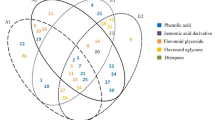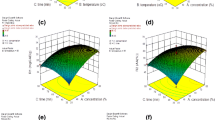Abstract
This study aimed to optimize the extraction conditions for Sorbus umbellata (Desf.) Fritsch var. umbellata leaves to maximize the phenolic content and their antioxidant activity and to investigate β-glucuronidase (GUS) enzyme inhibitory, antimicrobial and cytotoxic potentials of the extracts obtained under optimum conditions. The optimum extraction conditions were found to be 78.2 and 79.7% solvent, 73.1 and 71.5 °C, and 89.9 and 88.8 min to maximize phenolic content and antioxidant activity, respectively. Low values of coefficient of variations indicate the high reliability and reproducibility of the conducted extraction experiments. Bioactivity results showed that extracts had cytotoxic effect on the MCF-7 and A549 cells where the highest cell proliferation inhibition was observed for the A549 cell line (71.8% at 150 μg/mL). Staphylococcus aureus showed highest zone of inhibition (19.3 mm) in all bacteria followed by Escherichia coli. Additionally, extracts displayed potential GUS inhibitory activity. In conclusion, Sorbus umbellata leaf extract can be obtained by optimized cost-saving extraction and has a potential bioactivity to be utilized as a food ingredient for high value-added products and/or nutraceuticals development where it can combat oxidative stress and GUS mediated reactive metabolite formation.
Similar content being viewed by others
References
Korkut S, Güller B, Aytın A, Kök MS (2009) Turkey’s native wood species: physical and mechanical characterization and surface roughness of rowan. (Sorbus aucuparia L). Wood Res 54:19–30
Gültekin HC, Alan M (2007) Türkiye’nin üvezleri. Floraplus Dergisi 12:76–82 in Turkish
Fakir H, Korkmaz M, Güller B (2009) Medicinal plant diversity of Western Mediterrenean region in Turkey. J App Bio Sci 3(2):30–40
Kültür Ş (2007) Medicinal plants used in Kırklareli Province (Turkey). J Ethnopharmacol 111:341–364
Janghu S, Bera MB, Nanda V, Rawson A (2017) Study on power ultrasound optimization and its comparison with conventional thermal processing for treatment of raw honey. Food Technol Biotech 55:570–579. https://doi.org/10.17113/ftb.55.04.17.5263
Akdeniz B, Kavak DD, Bağdatlıoğlu N (2012) Use of factorial experimental design for analyzing the effect of storage conditions on color quality of sun-dried tomatoes. Sci Res Essays 7:477–489. https://doi.org/10.5897/SRE11.1372
Demir H, Sezer S, Süfer Ö (2017) Determination of factors affecting total color change of onion slices during drying using response surface methodology. Gıda 42(6):731–742. https://doi.org/10.15237/gida.GD17059
Wijangaard HH, Brunton N (2010) The optimization of solid-liquid extraction of antioxidants from apple pomace by response surface methodology. J Food Eng 96:134–140. https://doi.org/10.1016/j.jfoodeng.2009.07.010
Pompeu DR, Silva EM, Rogez H (2009) Optimisation of the solvent extraction of phenolic antioxidants from fruits of Euterpe oleracea using response surface methodology. Bioresour Technol 100:6076–6082. https://doi.org/10.1016/j.biortech.2009.03.083
Spigno G, De Faveri DM (2007) Antioxidants from grape stalks and marc: influence of extraction procedure on yield, purity and antioxidant power of the extracts. J Food Eng 78:793–801. https://doi.org/10.1016/j.jfoodeng.2005.11.020
Çam M, Aaby K (2010) Optimization of extraction of apple pomace phenolics with water by response surface methodology. J Agric Food Chem 58:9103–9111. https://doi.org/10.1021/jf1015494
Singleton VL, Orthofer R, Lamuela-Raventós RM (1999) Analysis of total phenols and other oxidation substrates and antioxidants by means of Folin-Ciocalteu reagent. Method Enzymol 299:152–178. https://doi.org/10.1016/S0076-6879(99)99017-1
Kavak DD (2017) Optimization of extraction time, temperature and solvent concentration for the antioxidant activity and total phenolic content of the Cydonia oblonga mill. leaves. Am-Eurasian J Sustain Agric 11(6):1–6
Sekikawa C, Kurihara H, Goto K, Takahashi K (2002) Inhibition of β-Glucuronidase by extracts of Chondria crassicaulis. Bulletin of the Faculty of Fisheries, Hokkaido University 53(1):27–30
Wu Y, Wang X, Xue J, Fan E (2017) Plant phenolics extraction from Flos chrysanthemi: response surface methodology based optimization and the correlation between extracts and free radical scavenging activity. J Food Sci 82:2726–2733. https://doi.org/10.1111/1750-3841.13916
Montgomery DC (2001) Design and analysis of experiments. John Wiley and Sons Inc, 5th Ed, New York, USA, pp 218–276
Aslan N, Cebeci Y (2007) Application of Box–Behnken design and response surface methodology for modeling of some Turkish coals. Fuel 86:90–97. https://doi.org/10.1016/j.fuel.2006.06.010
Khajeh M, Moghaddam MG, Danesh AZ, Khajeh B (2015) Response surface modeling of betulinic acid pre-concentration from medicinal plant samples by miniaturized homogenous liquid–liquid extraction and its determination by high performance liquid chromatography. Arab J Chem 8:400–406. https://doi.org/10.1016/j.arabjc.2013.03.001
Majd MH, Rajaei A, Bashi DS, Mortazavi SA, Bolourian S (2014) Optimization of ultrasonic-assisted extraction of phenolic compounds from bovine pennyroyal (Phlomidoschema parviflorum) leaves using response surface methodology. Ind Crop Prod 57:195–202. https://doi.org/10.1016/j.indcrop.2014.03.031
Hukkanen AT, Pölönen SS, Karenlampi SO, Kokko HI (2006) Antioxidant capacity and phenolic content of sweet rowanberries. J Agric Food Chem 54:112–119. https://doi.org/10.1021/jf051697g
Olszewska MA, Presler A, Michel P (2012) Profiling of phenolic compounds and antioxidant activity of dry extracts from selected Sorbus species. Molecules 17:3093–3113. https://doi.org/10.3390/molecules17033093
Olszewska MA (2011) In vitro antioxidant activity and total phenolic content of the inflorescences, leaves and fruits of Sorbus torminalis (L.) Crantz. Acta Pol Pharm 68:945–953
Shang YF, Kim SM, Um BH (2014) Optimisation of pressurised liquid extraction of antioxidants from black bamboo leaves. Food Chem 154:164–117. https://doi.org/10.1016/j.foodchem.2013.12.050
Başpınar Y, Üstündaş M, Bayraktar O, Sezgin C (2017) Response surface methodology for extraction of curcumin from turmeric and piperine from black pepper. CBU J Sci 13(3):747–754. https://doi.org/10.18466/cbayarfbe.339351
Samuagam L, Sia CM, Akowuah GA, Okechukwu PN, Yim HS (2013) The effect of extraction conditions on total phenolic content and free radical scavenging capacity of selected tropical fruits’ peel. Health Environ J 4:80–102
Rostagno MA, Palma M, Barroso CG (2004) Pressurized liquid extraction of isoflavones from soybeans. Anal Chim Acta 522:169–177. https://doi.org/10.1016/j.aca.2004.05.078
Radojkovic M, Zekovic Z, Jokic S, Vidovic S (2012) Determination of optimal extraction parameters of mulberry leaves using response surface methodology (RSM). Rom Biotech Lett 17:7295–7308
Kavak DD, Ülkü S (2015) Kinetic and equilibrium studies of adsorption of β-glucuronidase by clinoptilolite-rich minerals. Process Biochem 50:221–229. https://doi.org/10.1016/j.procbio.2014.12.013
Cacace JE, Mazza G (2003) Mass transfer process during extraction of phenolic compounds from milled berries. J Food Eng 59:379–389. https://doi.org/10.1016/S0260-8774(02)00497-1
Jimenez P, Cabrero P, Basterrechea JE, Tejero J, Cordoba-Diaz D, Cordoba-Diaz M, Girbes T (2014) Effects of short-term heating on total polyphenols, anthocyanins antioxidant activity and lectins of different parts of dwarf elder (Sambucus ebulus L.). Plant Foods Hum Nutr 69:168–174
Dong J, Liu Y, Liang Z, Wang W (2010) Investigation on ultrasound-assisted extraction of salvianolic acid B from Salvia miltiorrhiza root. Ultrason Sonochem 17:61–65. https://doi.org/10.1016/j.ultsonch.2009.05.006
Olszewska MA (2008) Separation of quercetin, sexangularetin, kaempferol and isorhamnetin for simultaneous HPLC determination of flavonoid aglycones in inflorescences, leaves and fruits of three Sorbus species. J Pharmaceut Biomed 48:629–635. https://doi.org/10.1016/j.jpba.2008.06.004
Rutkowska M, Owczarek A, Kolodziejczyk-Czepas J, Michel P, Piotrowska DG, Kapusta P, Nowak P, Olszewska MA (2019) Identification of bioactivity markers of Sorbus domestica leaves in chromatographic, spectroscopic and biological capacity tests: application for the quality control. Phytochem Lett 30:278–287
Ji L, Jiang P, Lu B, Sheng Y, Wang X, Wang Z (2013) Chlorogenic acid, a dietary polyphenol, protects acetaminophen-induced liver injury and its mechanism. J Nutr Biochem 24:1911–1919
Marcela A. Vazquez-Prieto MA, Bettaieb A, . Haj FG, Fraga CG,, Oteiza PI, (2012) Epicatechin prevents TNFα-induced activation of signaling cascades involved in inflammation and insulin sensitivity in 3T3-L1 adipocytes. Arch Biochem Biophy 527:113-118
Acknowledgements
The authors gratefully acknowledge the financial support of the Afyon Kocatepe University Scientific Research Projects Coordinatory Unit (Project No: 12.TEMATIK.05).
Author information
Authors and Affiliations
Corresponding author
Ethics declarations
Conflict of Interest
Authors have no conflict of interest to declare.
Additional information
Publisher’s Note
Springer Nature remains neutral with regard to jurisdictional claims in published maps and institutional affiliations.
Electronic supplementary material
ESM 1
(DOCX 18 kb)
ESM 2
(DOCX 13 kb)
ESM 3
(DOCX 17 kb)
ESM 4
(DOCX 13 kb)
ESM 5
(DOCX 12 kb)
ESM 6
Response surface for the effects of independent variables on total phenolic content TP (R1) and radical scavenging activity AA% (R2). (a) R1 according to solvent concentration and extraction temperature, (b) R1 according to extraction temperature and time, (c) R2 according to extraction temperature and time, (d) R2 according to solvent concentration and extraction temperature (PNG 4166 kb)
ESM 7
HPLC chromatogram of Sorbus leaf extract (3:catechin hydrate, 5:chlorogenic acid, 6:caffeic acid, 7:epicatechin, 10:p-coumaric acid, 11:ferulic acid, 15: rutin, 21:quercetin) (DOCX 18 kb)
ESM 8
β-Glucuronidase inhibitory effects of Sorbus leaf extract (5–150 μg/mL) (PNG 1050 kb)
ESM 9
Cytotoxicity results in terms of cell proliferation inhibiton (%) of Sorbus leaf extract (5–150 μg/mL) against MCF-7 breast adenocarcinoma cell line, and 549 lung adenocarcinoma cell line (PNG 1370 kb)
Rights and permissions
About this article
Cite this article
Kavak, D.D., Akdeniz, B. Sorbus umbellata (Desf.) Fritsch var. umbellata Leaves: Optimization of Extraction Conditions and Investigation Antimicrobial, Cytotoxic, and β-Glucuronidase Inhibitory Potential. Plant Foods Hum Nutr 74, 364–369 (2019). https://doi.org/10.1007/s11130-019-00743-9
Published:
Issue Date:
DOI: https://doi.org/10.1007/s11130-019-00743-9




